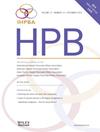Indication model for laparoscopic repeat liver resection in the era of artificial intelligence: machine learning prediction of surgical indication
IF 2.7
3区 医学
Q2 GASTROENTEROLOGY & HEPATOLOGY
引用次数: 0
Abstract
Background
Laparoscopic repeat liver resection (LRLR) is still a challenging technique and requires a careful selection of indications. However, the current difficulty scoring system is not suitable for selecting indications. The purpose of this study is to develop the indication model for LRLR using machine learning and to identify factors associated with open conversion (OC).
Methods
Patients who underwent repeat hepatectomy (2017-2021) at Samsung Medical Center 2021 were investigated. Multiple indication models were developed using machine learning techniques (random forest, SVM, XGB) and logistic regression. The predictive performance of these models was compared, and risk factors associated with OC were analyzed.
Results
Among 221 patients (110 LRLR, 111 ORLR), the ORLR group had a higher previous open approach rate (75.7% vs. 38.2%, p<0.001). Twice previous abdominal surgery was the only independent OC risk factor (OR 6.56, p=0.009). The indication model showed moderate predictive power (random forest AUC=0.779, logistic regression AUC=0.725, p=0.710). Important variables were previous laparoscopic approach, present subsegmentectomy, and left-sided tumor location.
Conclusion
The performance of the indication model for LRLR showed moderate predictive power in both machine learning and logistic regression. The important variables for LRLR were previous laparoscopic approach, present subsegmentectomy, and left side location.
人工智能时代腹腔镜重复肝切除术的适应症模型:手术适应症的机器学习预测。
背景:腹腔镜重复肝切除术(LRLR)仍然是一项具有挑战性的技术,需要仔细选择适应症。然而,目前的难度评分系统并不适合选择适应症。本研究的目的是利用机器学习开发LRLR的指示模型,并确定与开放转换(OC)相关的因素。方法:对三星首尔医院2021年(2017-2021年)接受重复肝切除术的患者进行调查。使用机器学习技术(随机森林、支持向量机、XGB)和逻辑回归建立了多指标模型。比较了这些模型的预测性能,并分析了与OC相关的危险因素。结果:221例患者(110例LRLR, 111例ORLR)中,ORLR组既往开放入路率较高(75.7% vs. 38.2%)。结论:LRLR的适应症模型在机器学习和逻辑回归中均表现出中等的预测能力。LRLR的重要变量是以前的腹腔镜入路,现在的亚节段切除术和左侧位置。
本文章由计算机程序翻译,如有差异,请以英文原文为准。
求助全文
约1分钟内获得全文
求助全文
来源期刊

Hpb
GASTROENTEROLOGY & HEPATOLOGY-SURGERY
CiteScore
5.60
自引率
3.40%
发文量
244
审稿时长
57 days
期刊介绍:
HPB is an international forum for clinical, scientific and educational communication.
Twelve issues a year bring the reader leading articles, expert reviews, original articles, images, editorials, and reader correspondence encompassing all aspects of benign and malignant hepatobiliary disease and its management. HPB features relevant aspects of clinical and translational research and practice.
Specific areas of interest include HPB diseases encountered globally by clinical practitioners in this specialist field of gastrointestinal surgery. The journal addresses the challenges faced in the management of cancer involving the liver, biliary system and pancreas. While surgical oncology represents a large part of HPB practice, submission of manuscripts relating to liver and pancreas transplantation, the treatment of benign conditions such as acute and chronic pancreatitis, and those relating to hepatobiliary infection and inflammation are also welcomed. There will be a focus on developing a multidisciplinary approach to diagnosis and treatment with endoscopic and laparoscopic approaches, radiological interventions and surgical techniques being strongly represented. HPB welcomes submission of manuscripts in all these areas and in scientific focused research that has clear clinical relevance to HPB surgical practice.
HPB aims to help its readers - surgeons, physicians, radiologists and basic scientists - to develop their knowledge and practice. HPB will be of interest to specialists involved in the management of hepatobiliary and pancreatic disease however will also inform those working in related fields.
Abstracted and Indexed in:
MEDLINE®
EMBASE
PubMed
Science Citation Index Expanded
Academic Search (EBSCO)
HPB is owned by the International Hepato-Pancreato-Biliary Association (IHPBA) and is also the official Journal of the American Hepato-Pancreato-Biliary Association (AHPBA), the Asian-Pacific Hepato Pancreatic Biliary Association (A-PHPBA) and the European-African Hepato-Pancreatic Biliary Association (E-AHPBA).
 求助内容:
求助内容: 应助结果提醒方式:
应助结果提醒方式:


